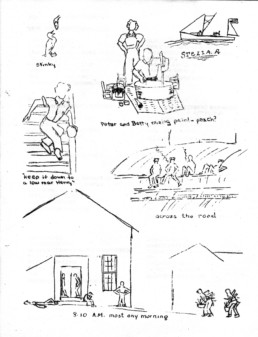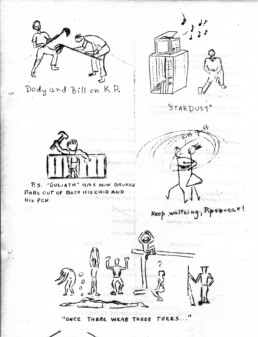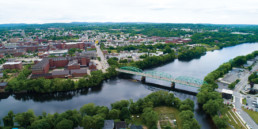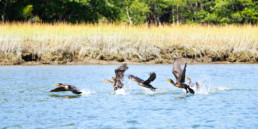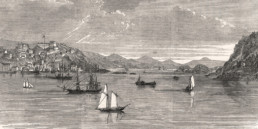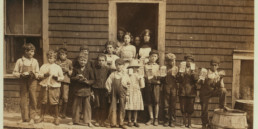The Summer of ’43, When Quakers Landed on Vinalhaven
While World War II raged, urban teens visited a Maine island to work.
BY HARRY GRATWICK
By 1943, the World War seemed endless. The news carried stories of victories and defeats, liberation and slaughter.
In February of that year, the German siege of Stalingrad in Russia ended, but in Poland, the Warsaw Ghetto had been destroyed. In May, Germany’s Afrika Korps surrendered. This was followed by the devastation of Hamburg, the result of Allied bombing, in July. In the Pacific, after eight bloody months, the Guadalcanal campaign was successful, and in August, the young John Kennedy’s PT boat was sunk in the Solomon Islands.
But for a group of high school students at a Quaker work camp on the Penobscot Bay island of Vinalhaven, the war must have seemed far away. Recently, logs dutifully recorded by campers and staff during that summer were discovered in the archives of the American Friends Service Committee (AFSC) in Philadelphia. They provide a glimpse of that island experience over seventy years ago.
The Quaker commitment to peace would be recognized only after the horrors of that worldwide conflict. The organization won the Nobel Peace Prize in 1946 and 1947.
The previous August, Edward R. Miller, representing AFSC, had visited Vinalhaven seeking a site for a Quaker work camp. In his report, Miller bluntly described a town that had fallen on hard times. What had been a flourishing boatbuilding, shipping, quarrying, and fishing community had declined to the extent that mainland banks were refusing loans to anyone on the island.
Miller’s views may seem a harsh evaluation for someone who had only visited Vinalhaven for a few days. Although there was still some lobstering and a couple of dairy farms, people were leaving the island in droves to look for jobs on the mainland, and many of the young men had enlisted in the military. An additional problem was that the island ferry had been pressed into service by the US Coast Guard.
Urban Teens
The 20 teenagers in the work camp were a varied lot: most were from Philadelphia, New York, and Boston, although several were refugees from Europe. The group arrived in Rockland by train and was transported to Vinalhaven by lobster boat. Arriving after dark, they trudged up a hill to an old house—which locals said was haunted—with no electricity above the first floor. Things looked better in the daylight, and the first weekend was spent settling in and repairing what would be their home for the next two months.
Bill Carey and Karl Spaeth are now in their 80s, but both remember that summer. Carey, who teaches pediatric medicine at Children’s Hospital in Philadelphia, recalls spending most of his time working on the town hall, the building now occupied by the Vinalhaven Historical Society.
“We lived in a house about fifty yards away. The girls, and a chaperone, were on the second floor; the boys were on the third. The first floor was used for Quaker meetings and recreation, such as record playing. There was running water but the toilets were indoor privies,” he recalled recently. The group leaders and the cook stayed in an adjacent house.
“The purpose of the work camp,” Carey explained, “besides keeping a group of generally overprivileged adolescents busy, was to bring some amateur construction to aid a rather poor seacoast town. I got used to sustained physical work as never before. Our chief recreation was swimming in the quarry. A great treat was to go down to the drugstore for a Boston Cooler, a delicious mixture of root beer and vanilla ice cream.”
Spaeth is a retired lawyer, and today remembers being the youngest member of the group. He had just finished eighth grade at Germantown Friends School, and was nicknamed “the professor” by some of the older students, who were impressed with his knowledge of the sciences, well developed for someone not yet in high school.
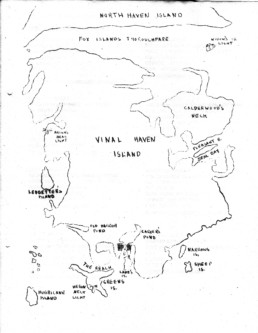
Our campers are more chummy than ever with various local boys. Dreamy, Herbert Junior, Penny, Ralph, Weepy, Victor, and the rest are personalities we shan’t forget.
— from the camp log
The major project, repair of the town hall, began almost immediately. “We joyously and noisily tore down the lockers with menacing-looking wrecking bars,” Spaeth remembers.
For the rest of the summer, campers were scattered around the building, removing interior partitions, excess lumber, and trash. Then it was on to plastering, putting up drywall, replacing windows, and, finally, painting the walls and ceiling. Rebuilding the stage, reinforcing the balcony, and constructing two dressing rooms were particularly challenging jobs, the men remember.
Spaeth also remembers the campers spending considerable time digging an extensive drainage ditch around a nearby schoolhouse. That project provided a practical upgrade, because in previous winters, children had had to wade through water to get into the building. Loads of granite chips were lugged in to fill up the ditch, which was then covered with sand.
On the playground, new sandboxes with covers were built, and new swing sets, slides, and a seesaw were installed. Finally, the entire area was leveled and resurfaced with gravel.
Community Interaction
The staff was concerned that the work camp not be seen as a summer frolic by a bunch of rich kids from East Coast prep schools. As a result, every effort was made to follow through on work projects while engaging the Vinalhaven community on a variety of levels.
Over time, integration with the community succeeded. Twice a week “Play Day” programs were established for younger island children, and the staff was gratified when as many as forty children would show up. At the end of the summer, there was an enthusiastic and well-attended grand opening of the town hall, complete with skits, songs, and a recital by the camp band.
The local teens were a hard sell, though. In the log, a counselor recorded his observations: “The day usually began with a gallery of local boys lounging on the fence across the road. . . . [They were] cigarette-smoking, ice-cream-eating lads with a high incidence of profanity.”
As the summer progressed, though, the logs noted that the attitudes toward the visitors changed: “We had a good deal of help from village youths. Yesterday there were six of them helping out.”
Of course, the town selectmen added leverage, repeatedly urging island boys and girls to pitch in on the projects.
As the Vinalhaven boys began hanging around with increasing frequency, the camp log reported: “Our campers are more chummy than ever with various local boys. They are no longer problem youths to us. Dreamy, Herbert Junior, Penny, Ralph, Weepy, Victor, and the rest are personalities we shan’t forget.”
At the end of the workday, there were always a few island boys wanting to know if anyone (especially the girls) wanted to go swimming. In fact, on many afternoons, most of the campers went swimming in nearby Sand’s Quarry, where they often met up with island teens. A sign of increasing camaraderie was when, after a dip in the East Boston Quarry, the camp boys discovered a prankster had hidden their clothes. Quite a few were late for supper that night.
Recreational activities included baseball games umpired by the local minister, Mr. Mitchell, as well as dances. According to one of the counselors, the local teens were initially afraid that the visiting Quakers “might be too religiously minded to indulge in such irrelevant activities as dancing.”
However, as Bill Carey reported, the Saturday-night dances in the town hall became “a meaningful weekly point of contact with the citizenry.” He remembers that a local dance favorite was the Lady of the Lake, “a distant relative of the Virginia Reel.”
One night, a dispute arose among the campers when the boys alleged that some girls were “egging on” the town boys, only to give them the “stop sign” later in the evening. During the ensuing discussion, the son of a prominent Quaker was quoted as saying, “You make me so angry that I would punch you on the nose if I were not a Quaker.” The campers “thrashed things out,” and it was agreed that limits would be set on “local swains.”
As the summer progressed, the staff found it a challenge to keep the campers busy. A staff member wrote, “Our camp tends all too easily to develop into a compromise between a work camp and a summer resort.”
When some of the boys began to take on odd jobs after hours, a potentially awkward situation was created, since in doing so they were taking income away from islanders. After some discussion, it was decided to create a pool of the wages, which would be “devoted to some useful end,” presumably to help out island families.
Although German sub-marines prowled the Maine coast, Carey said the prevailing attitude was not fear. “Sub-marines weren’t likely to waste torpedoes or ammunition on lobster boats,” he said.
Nevertheless, for teenagers on a Maine island in the summer of 1943, the war was never far from their thoughts. The Vinalhaven doctor was an Englishwoman on crutches whose legs had been crushed in the London Blitz. And 16 months after that island summer, Carey would be serving on a tanker in the Pacific.
At one point, there was a discussion among the campers about pacifism, and it became quite heated. In the end, it was agreed that those who were not pacifists learned much from those who were.
As the summer drew to a close one camper wrote, “In a world in which such horrible activities as war and race massacres are going on, we are fortunate in being able to serve by loving and helping our neighbors on this beautiful, invigorating island.”

